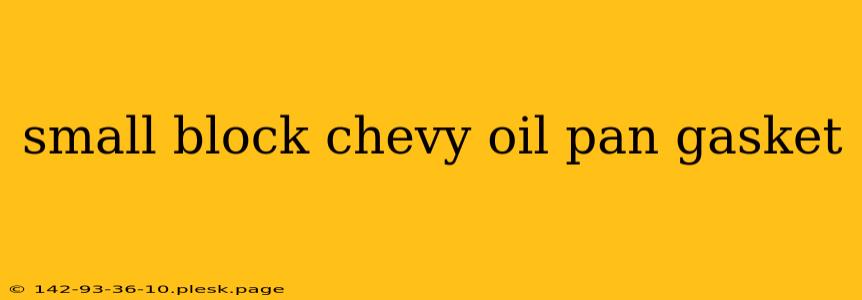Replacing a small block Chevy oil pan gasket might seem like a straightforward task, but choosing the right gasket and ensuring a proper installation is crucial for preventing oil leaks and maintaining engine health. This comprehensive guide delves into the nuances of selecting the appropriate gasket, the step-by-step installation process, and troubleshooting common issues.
Understanding Small Block Chevy Oil Pan Gaskets
Small block Chevy engines, renowned for their power and reliability, utilize oil pan gaskets to seal the oil pan to the engine block. These gaskets come in various materials, each with its own strengths and weaknesses. Common materials include:
-
Cork: A traditional choice, cork gaskets are relatively inexpensive but can be less durable and prone to shrinking or hardening over time. They're generally suitable for low-stress applications and less demanding driving conditions.
-
Rubber: Rubber gaskets offer improved durability and resilience compared to cork. They often provide a better seal, especially in situations with higher engine vibrations or temperature fluctuations. Several types of rubber compounds are used, offering varying degrees of resistance to heat and oil.
-
Silicone: Silicone gaskets are known for their excellent sealing properties and resistance to high temperatures and harsh chemicals. They’re a popular choice for high-performance applications or when a particularly robust seal is required. However, they can be more challenging to install correctly.
-
Fel-Pro PermaTorque: This is a popular choice and is known for its superior sealing capability. It uses a combination of materials and a unique design to ensure a robust and long-lasting seal.
Choosing the right gasket depends on your specific needs and the condition of your engine. Always refer to your engine's specifications or consult a reputable auto parts supplier to ensure compatibility.
Selecting the Right Oil Pan Gasket
Before purchasing, confirm the following:
-
Engine Year and Model: Different years and models of small block Chevy engines may have slightly different oil pan designs, requiring specific gasket sizes and configurations.
-
Oil Pan Type: The type of oil pan (e.g., stock, aftermarket, high-capacity) will dictate the gasket's shape and dimensions.
-
Gasket Material: Consider the material based on your needs and budget, as discussed above.
Step-by-Step Installation of a Small Block Chevy Oil Pan Gasket
Tools and Materials:
- New oil pan gasket
- New oil pan bolts (recommended)
- Socket set
- Torque wrench
- Oil pan
- Clean rags or shop towels
- Engine degreaser (optional)
- RTV Silicone sealant (for some gaskets)
Procedure:
-
Drain the Engine Oil: Completely drain the engine oil before removing the oil pan.
-
Remove the Oil Pan: Carefully remove the oil pan bolts, paying attention to their order and location for reinstallation. Some pans might require additional steps like removing the pickup tube.
-
Clean the Surfaces: Thoroughly clean the mating surfaces of both the engine block and the oil pan. Remove any old gasket material, dirt, or debris. An engine degreaser can be helpful.
-
Apply RTV Silicone (if needed): Certain gaskets may require a bead of RTV silicone sealant along the mating surfaces. Follow the gasket manufacturer's instructions carefully.
-
Install the New Gasket: Carefully position the new gasket onto the engine block, ensuring it is properly seated.
-
Install the Oil Pan: Carefully lower the oil pan onto the gasket, aligning the bolt holes.
-
Tighten the Bolts: Tighten the oil pan bolts in a crisscross pattern, gradually increasing the torque. Refer to your engine's specifications or a workshop manual for the correct torque specifications.
Troubleshooting Oil Leaks
Despite careful installation, oil leaks can still occur. Common causes include:
-
Incorrect Gasket Installation: Double-check for proper gasket alignment and seating.
-
Damaged Oil Pan or Engine Block Surfaces: Scratches or imperfections on the mating surfaces can prevent a proper seal.
-
Over- or Under-tightened Bolts: Ensure bolts are tightened to the specified torque. Over-tightening can warp the pan, while under-tightening can lead to leaks.
-
Incorrect Gasket Selection: Using the wrong gasket for your engine can result in leaks.
By carefully following these steps and troubleshooting potential issues, you can effectively replace your small block Chevy oil pan gasket and prevent costly oil leaks. Remember to always consult your engine's service manual for specific instructions and torque specifications.

